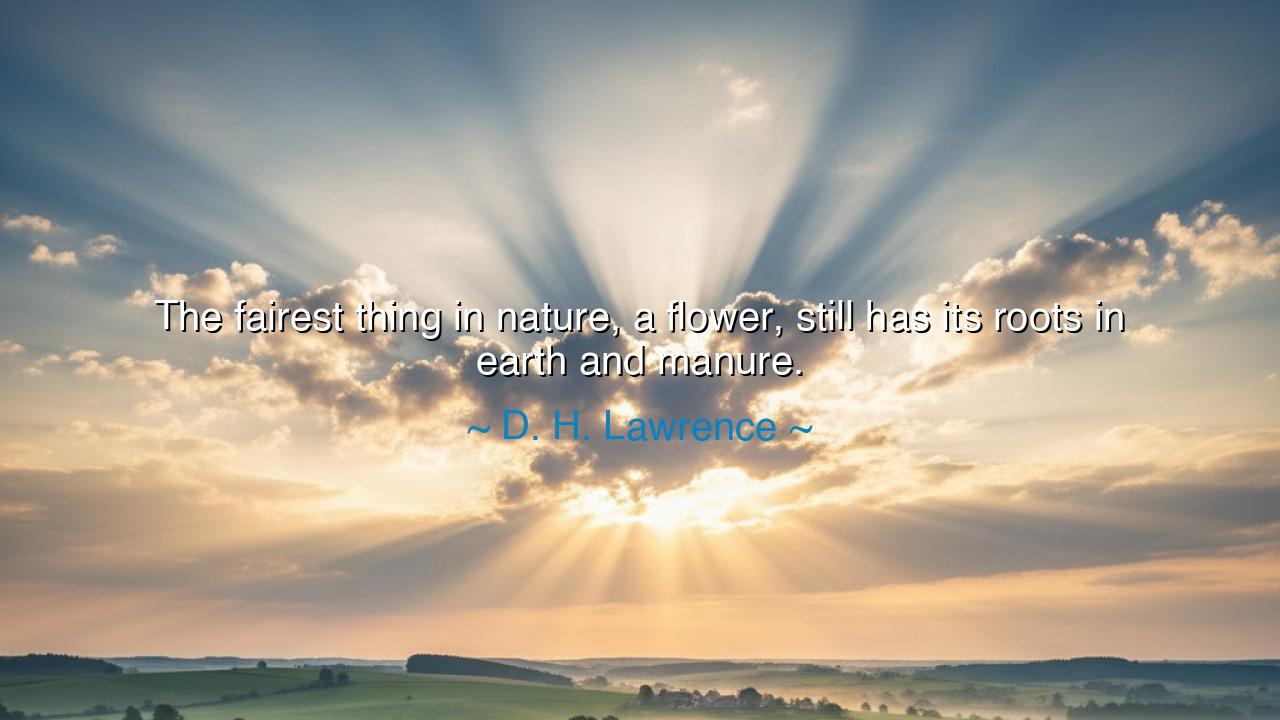
The fairest thing in nature, a flower, still has its roots in






Hear, O seeker of truth, the words of D. H. Lawrence, who spoke with piercing insight: “The fairest thing in nature, a flower, still has its roots in earth and manure.” In this saying lies the eternal paradox of life—that beauty is born not from purity alone, but from mingling with what is base and lowly. The flower, which enchants the eye and perfumes the air, rises only because it has sunk its roots into the dark soil, into decay, into that which men despise. Thus Lawrence reminds us that all greatness is fed by struggle, all nobility by humility, all radiance by what lies beneath.
The origin of this thought springs from Lawrence’s vision of life as raw, passionate, and inseparable from the forces of the earth. He scorned the notion of beauty as something detached from struggle or dirt. Instead, he declared that the sublime and the sordid are bound together, as the blossom is bound to the soil. His words teach that even the most exalted things are nourished by what the world calls foul. The manure that offends the senses is precisely what strengthens the stem and feeds the bloom.
Consider the story of Michelangelo, the sculptor who drew angels from stone. His masterpieces, admired by kings and pilgrims alike, were born of sweat, dust, and aching toil. The Sistine Chapel’s ceiling dazzles with divine figures, yet beneath that glory was the stench of sweat, the pain of a bent back, the filth of scaffolding and paint-stained hands. Just as the flower rises from manure, so the world’s greatest beauty emerged from labor’s hardship. The glory we see above is inseparable from the struggle below.
So too, history reminds us in the story of nations. Out of the ashes of war, from the ruin of cities and the blood of soldiers, often arises a new birth of freedom. The fairest flower of peace grows not apart from suffering but from its soil. After the American Civil War, the union was scarred and broken, yet from its earth and manure arose the slow blooming of emancipation and new hope. The lesson remains: that beauty and renewal demand roots in the hardest ground.
The meaning, then, is both humbling and ennobling. It humbles, because it teaches us not to despise the lowly or the unpleasant. Without earth and manure, there is no flower. Without trial, no triumph. Without failure, no growth. Yet it ennobles us too, for it proclaims that even our sufferings, our losses, our shames, can feed the roots of beauty yet to come. Nothing is wasted. All that is base may be transformed into fuel for what is higher.
Thus, the lesson for you, listener, is clear: do not scorn your struggles, nor despise the dirt through which you must pass. If you would be a flower, accept the manure that nourishes you. See your failures, your pains, your humiliations not as curses but as compost. They are the hidden sources of your strength, the unseen roots of your future bloom.
Practical actions are simple but profound. When hardship comes, do not curse it, but ask what roots it is feeding. When you labor in obscurity, know that blossoms grow slowly beneath the soil. When you stumble in weakness, trust that even this may enrich the soil of your soul. And above all, treat others with mercy, for they too are rooted in earth, struggling toward their own bloom.
So remember Lawrence’s teaching: “The fairest thing in nature, a flower, still has its roots in earth and manure.” Let it be your comfort in hardship, your humility in triumph, and your reminder that beauty and greatness are never free of struggle. For the blossom is glorious not because it is separate from the dirt, but because it rises from it.






AAdministratorAdministrator
Welcome, honored guests. Please leave a comment, we will respond soon